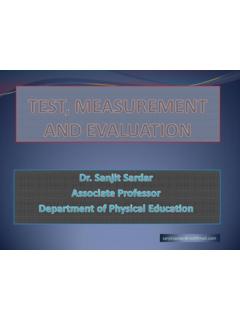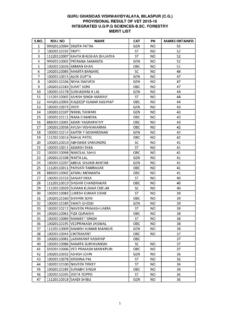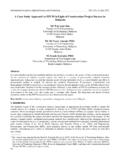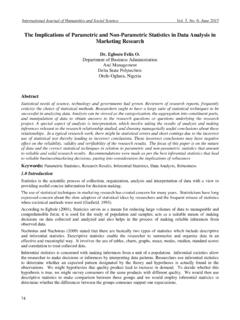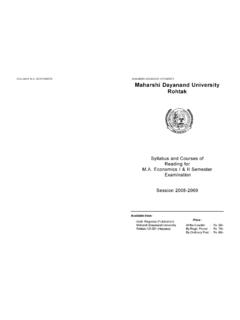Transcription of Model Answer/suggested solution Research …
1 Page 1 of 13 Model Answer/suggested solution Research Methodology M. Com (Third Semester) Examination, 2013 Paper Title: Research Methodology Paper Code: AS-2375 * (Prepared by Dr. Anuj Agrawal, Assistant Professor, Department of Commerce, GGV) Note: These Model answers are a depiction of important points which an examinee must have to mention to secure high marks in particular question. The length of the answer may vary as per the examinee s understanding, interpretation and his/her ability to comprehend the content. Short Answer Type Questions (i) Explanatory Research : Investigation into a problem or situation which provides insights to the researcher. The Research is meant to provide details where a small amount of information exists. Explanatory Research attempts to clarify why and how there is a relationship between two aspects of a situation or phenomenon.
2 This type of Research attempts to explain, for example, why stressful living results in heart attacks; why a decline in mortality is followed by fertility decline; or how the home environment affects children s level of academic achievement. (ii) Qualitative Research : Qualitative Research deals with phenomena that are difficult or impossible to quantify mathematically, such as beliefs, meanings, attributes, and symbols. Qualitative Research is especially important in the behavioral sciences where the aim is to discover the underlying motives of human behaviour. Through such Research we can analyze the various factors which motivate people to behave in a particular manner or which make people like or dislike a particular thing. (iii) Difference between Null and Alternate hypothesis: A Research hypothesis is an assertion about a particular phenomenon that is, typically, derived from a theory.
3 For example, we might assert that a particular independent variable will have an effect on a dependent measure. The Research hypothesis (usually indicated by the symbol H1). The null hypothesis (usually indicated Page 2 of 13 by the symbol H0) is the statement that the treatment manipulation will not have any effect - that there is zero effect due to the independent variable. A null hypothesis is "the hypothesis that there is no relationship between two or more variables. The alternate, or Research , hypothesis proposes a relationship between two or more variables. (iv) Need of Research Design: Research design acts as a firm foundation for the entire Research . It is needed because it facilitates the smooth functioning of the various Research operations. It makes the Research as efficient as possible by giving maximum information with minimal expenditure of effort, time and money.
4 For construction of a house, we need to have a proper blueprint prepared by an expert architect. Similarly, we need a proper Research design or plan prior to data collection and analysis of our Research project. (v) Schedule Method: A schedule is a structure of set of questions on a given topic which are asked by the interviewer or investigator personally. The order of questions, the language of the questions and the arrangement of parts of the schedule are not changed. However, the investigator can explain the questions if the respondent faces any difficulty. Schedule include open-ended questions and close-ended questions. Open-ended questions allow the respondent considerable freedom in answering. However, questions are answered in details. Close-ended questions have to be answered by the respondent by choosing an answer from the set of answers given under a question just by ticking.
5 (vi) Random Sampling: For a sampling design to be called a random or probability sample, it is imperative that each element in the population has an equal and independent chance of selection in the sample. The choice of an element in the sample is not influenced by other considerations such as personal preference. The choice of one element is not dependent upon the choice of another element in the sampling. The selection or rejection of one element does not affect the inclusion or exclusion of another. (vii) Disadvantage of Close ended-Questions: respondents with no opinion or no knowledge can answer anyway Close-ended questions, because of the simplicity and limit of the answers , may not offer the respondents choices that actually reflect their real feelings. Page 3 of 13 One of the main disadvantages of closed-ended questions is that the information obtained through them lacks depth and variety.
6 There is a greater possibility of investigator bias because the researcher may list only the response patterns that s/he is interested in or those that come to mind. (viii) Interpretation: Interpretation refers to the task of drawing inferences from the collected facts after an analytical and/or experimental study. In fact it is a search for broader meaning of Research findings. The usefulness and utility of Research findings lie in proper interpretation. (ix) After-only Design: In an after-only design the researcher knows that a population is being, or has been, exposed to an intervention and wishes to study its impact on the population. In this design, information on baseline is usually constructed on the basis of respondents recall of the situation before the intervention, or from information available in existing records. This design is widely used in impact assessment studies, as in real life many programs operate without the benefit of a planned evaluation at the program planning stage.
7 Page 4 of 13 A Research problem is a statement about an area of concern, a condition to be improved, a difficulty to be eliminated, or a troubling question that exists in scholarly literature, in theory, or in practice that points to the need for meaningful understanding and deliberate investigation. In some social science disciplines the Research problem is typically posed in the form of a question. Steps in the Formulation of Research Problem: Identify a broad field or subject area of interest to you Dissect the broad area into subareas Select what is of most interest to you Raise Research question Formulate objectives Access your objectives Double-check [Proper explanation of the points is required] Ans. 3 (i) Limitations of test of significance: There are several limitations of the said tests which should always be borne in mind by a researcher.
8 Important limitations are as follows: The tests should not be used in a mechanical fashion. It should be kept in view that testing is not decision-making itself; the tests are only useful aids for decision-making. Hence proper interpretations of statistical evidence is important to intelligent decisions. Tests do not explain the reasons as to why does the difference exist, say between the means of the two samples. They simply indicate whether the difference is due to fluctuations of sampling or because of other reasons but the tests do not tell us as to which is/are the other reason(s) causing the difference. Results of significance are based on probabilities and as such cannot be expressed with full certainty. When a test shows that a difference is statistically significant, then it simply suggests that the difference is probably not due to chance.
9 Statistical inferences based on the significance tests cannot be said to be entirely correct evidences concerning the truth of the hypotheses. This is specially so in case of small samples where the probability of drawing erring inferences happens to be generally higher. For greater reliability, the size of samples be sufficiently enlarged. Page 5 of 13 All these limitations suggest that in problems of statistical significance, the inference techniques (or the tests) must be combined with adequate knowledge of the subject-matter along with the ability of good judgment. Ans. 3 (ii) Type I error: Rejecting the null hypothesis when it is in fact true is called a Type I error. Many people decide, before doing a hypothesis test, on a maximum p-value for which they will reject the null hypothesis. This value is often denoted (alpha) and is also called the significance level.
10 Type II Error: Not rejecting the null hypothesis when in fact the alternate hypothesis is true is called a Type II error. The following Table summarizes Type I and Type II Errors: With a fixed sample size, n, when we try to reduce type I error, the probability of committing Type II error increases. Both types of errors can t be reduced simultaneously. There is a trade-off between these two types of errors which means that the probability of making one type of error can only be reduced if we are willing to increase the probability of making the other type of error. For example: The null hypothesis is "defendant is guilty;" the alternate is "defendant is not guilty." A Type II error would correspond to convicting an innocent person; a Type I error would correspond to setting a guilty person free. This has been shown in the table given below: Null Hypothesis (Ho) True Null Hypothesis (Ho) False Reject Null Hypothesis Type I Error Correct Decision Fail to reject Null Hypothesis Correct Decision Type II Error Page 6 of 13 Here in this example type II error is very serious from the point of view of Indian system of justice.
